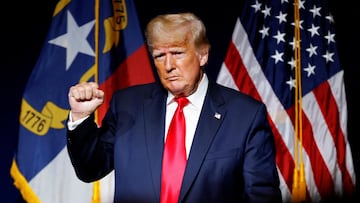CRYPTOCURRENCY
What does NFT mean? What is it and what is an example of it?
It seemed NFTs had died a death as quickly as they sprang up but former president Donald Trump has railed against the crypto crash by releasing his own NFTs

Many were expecting Donald Trump to announce his running mate last week but instead his announcement was the release of a new cryptocurrency-based collectible card set.
“They’re called Trump Digital Trading Cards,” he announced. “These cards feature some of the really incredible artwork pertaining to my life. You can collect your Trump Digital Cards just like a baseball card or other collectibles.”
While many mocked the idea, including members of his former entourage, the project has been a commercial success as all 45,000 cards meaning they made $4.5 million before other factors are taken into account.
NFT stands for “non-fungible token,” and it can technically contain anything digital, including drawings, animated GIFs, songs, or items in video games.
Non-fungible means it is individual. The opposite, fungible, has examples like bitcoin. One bitcoin can be swapped for another; they are identical. However, no two NFTs are the same.
NFTs allow you to buy and sell ownership of unique digital items and keep track of who owns them using the blockchain. An NFT can either be one-of-a-kind, like a real-life painting, or one copy of many, like trading cards, but the blockchain keeps track of who has ownership of the file.
In short, it is a digital version of owning art, an autograph, or basically anything digitally. Thus, the lure to own one is to show off in a digital space, as walking down the street people would not realize you own millions of dollars worth of digital monkeys (you’ll find out about them later).
What is the blockchain?
As a database, a blockchain stores information electronically in digital format. Blockchains are best known for their crucial role in cryptocurrency systems, such as Bitcoin, for maintaining a secure and decentralized record of transactions.
Blockchain ensures that the items can be stored as safe as possible. Decentralized blockchains are immutable, which means that the data entered is irreversible. For Bitcoin, this means that transactions are permanently recorded and viewable to anyone.
So what famous examples of NFTs are there?
The first-ever tweet, from creator Jack Dorsey, was sold for $2.9 million to an anonymous buyer. Dorsey retains control of the tweet, but the buyer basically owns it like an autograph.
Another example is that of the Bored Ape Yacht Club, a collection created by Jimmy “j1mmy.eth” McNelis. They are a bunch of AI-generated digital apes. A group of them has recently been bought by Universal Music to form a band.
No, I don’t understand that bit either.
“You can call it an NFT band, or think of them as characters,” former Sony exec Celine Joshua said in a statement, via Bloomberg. “The characters will come to life. The apes will come to life.”
Perhaps she has forgotten the British band Gorillas, which is basically the same premise but done 20 years ago.
This is all tied into an idea called the metaverse, a futuristic, or dystopian, design where people will live parallel lives in a 3D space. Facebook has made big inroads into this project, as founder Mark Zuckerberg is a big proponent of the idea.
NFTs and cryptocurrency have lost the majority of their value in the last year. The collapse of big trading exchanges like FTX is affecting all cryptocurrency prices as it seems people are beginning to lose faith. For one example, Bored Ape Yacht Club has seen its market cap fall by $2 billion in the past eight months, according to Crypto Presales.
The environmental impact
There are a lot of greenhouse gas emissions tied to NFTs. For one, they’re largely bought and sold in marketplaces like Nifty Gateway and SuperRare that use the cryptocurrency Ethereum. Ethereum, like most major cryptocurrencies, is built on a system called “proof of work” that uses a lot of energy. People “mine”, that is crack computer code, by using thousands of computers. They are then rewarded with a token.
Digiconomist estimates the amount of electrical energy produced by Ethereum is that of the entire country of Belgium, and the continued proliferation of NFTs only makes the system use more and more energy.






